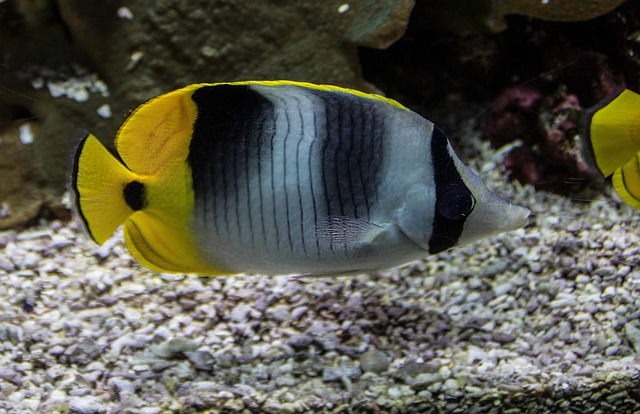Designing museum-quality aquariums is an art form that combines aesthetics and ecology. By replicating diverse marine environments with naturalistic features like rocky substrates, live plants, and precise lighting, aquascapers create immersive underwater scenes. Every element, from rock formations to tank shape, contributes to both visual appeal and ecological balance, resulting in captivating aquatic displays that merge art and functionality.
Discover the art of innovative aquascaping and transform your marine landscape into a breathtaking underwater masterpiece. This guide explores the secrets behind creating museum-quality aquariums, delving into key design elements, from tank size and shape to advanced lighting techniques. Learn how to incorporate living plants, unique decorative touches, and sustainable practices for an aquarium that’s both ecologically balanced and visually stunning.
Designing Museum-Quality Aquariums: The Foundation of Aquascaping
Designing museum-quality aquariums is an art form that lies at the heart of aquascaping. These stunning water features, akin to miniature oceans within a confined space, demand meticulous planning and execution. The goal is to create scenes that mimic nature’s beauty while offering a unique visual experience. Each element, from the placement of rocks and plants to the selection of fish and lighting, plays a crucial role in crafting an immersive, captivating display.
Museum-quality aquariums transcend mere functionality; they become living exhibits that spark curiosity and awe. Aquascapers strive for realism, often drawing inspiration from diverse marine environments worldwide. By focusing on intricate details, such as current flows, shadow play, and the strategic use of colors, these creations transform ordinary tanks into breathtaking works of art. The result is a visual journey that captivates both casual observers and passionate aquarium enthusiasts alike.
– Key elements for creating a visually stunning aquarium
Creating a visually stunning aquarium involves carefully curating several key elements that transform it into a miniature marine landscape. First, museum-quality aquariums prioritize naturalism by replicating the diverse ecosystems found in the wild. This includes selecting appropriate substrate types, such as rocky outcrops and sandy beds, to mimic the natural habitat of the aquatic life within. Live plants add depth and vibrancy, promoting ecological balance and providing hiding spots for fish.
The choice of aquarium lighting is another critical aspect, as it dramatically influences the overall aesthetics. Specialized LED lights offer precise color spectra that enhance the beauty of coral reefs, algae, and other phototropic organisms. Careful placement of these lights ensures even illumination across the tank, preserving the vivid colors and intricate textures of its inhabitants. Additionally, incorporating unique decor pieces like driftwood, cave formations, or artistic sculptures adds a touch of creativity, elevating the aquarium from a simple container to an art form that captivates viewers.
– Importance of aesthetics and functionality in design
In the realm of aquascaping, the marriage between aesthetics and functionality is a true masterpiece. When crafting a museum-quality aquarium, every element must contribute to both the visual allure and the ecological balance. The design should be a symphony where plants, decor, and water features dance in harmony, creating a captivating underwater landscape. Each component plays a vital role, from the smooth curves of rock formations to the intricate arrangements of aquatic flora. These elements not only elevate the beauty of the aquarium but also serve practical purposes—providing hiding spots for fish, stabilizing water temperature, and enhancing oxygen levels.
This balance ensures that the aquarium is more than just a stunning work of art; it’s a thriving ecosystem where form follows function. Skilled aquascapers meticulously plan each layer, from the substrate to the canopy, ensuring every detail complements the overall design while supporting the marine life within. The result is an immersive experience that captivates viewers, offering a glimpse into the beauty and complexity of the underwater world, all while maintaining a harmonious environment for its aquatic inhabitants.
– Choosing the right tank size and shape
When designing a marine landscape that’s fit for a museum-quality aquarium, one of the first considerations is selecting the optimal tank size and shape. The dimensions should align with your desired aesthetic and the available space in your home or exhibition area. Longer tanks create a more dynamic view, showcasing diverse aquatic habitats like coral reefs or underwater forests, while taller tanks can replicate the verticality of nature, ideal for displaying plants and creatures that thrive in such environments.
The shape also plays a crucial role in aquascaping. Rectangular tanks offer a classic look, allowing for precise planning and arrangement of elements. Circular tanks, on the other hand, provide a unique, seamless view from any angle, enhancing the immersive experience. Oval or custom-shaped tanks can add a touch of elegance, catering to specific design themes. Choosing the right size and shape sets the foundation for a breathtaking aquatic landscape that captivates viewers.
Innovative aquascaping transforms ordinary aquariums into breathtaking marine landscapes. By focusing on designing museum-quality aquariums that seamlessly blend aesthetics and functionality, aquarists can create stunning visual experiences. The key lies in carefully considering tank size, shape, and essential design elements to craft a harmonious underwater world that captivates and inspires.
